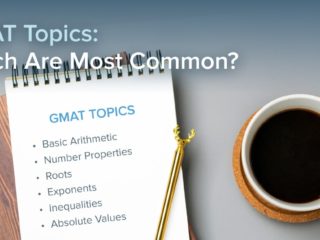Last Updated on May 15, 2023
In my work with GMAT students over the past 15 years, I have consistently heard the question, “When should I use a combination and when should I use a permutation?” In this article, we will get to the bottom of this question. Along the way, we will look at examples that illustrate how to decide which to use.
Here Are the Topics We’ll Cover:
- What Is the Difference Between a Combination and a Permutation?
- When to Use a Combination vs. a Permutation
- Applying What We’ve Learned
- What’s Next?
What Is the Difference Between a Combination and a Permutation?
So, what is the difference between a combination and permutation?
The short answer to this question is that in a combination, the order of selection of the items does not matter.
On the other hand, in a permutation, the order of selection of the items does matter.
Let’s explore this distinction in further detail.
When the Selection Order Does Not Matter, We Use a Combination
Let’s consider a concrete example. Say that 8 people — Asmah, Charlotte, Emmanuel, Henry, Jasmine, Jerimiah, Ninie, and Panpan — are available to be selected for a 4-person soccer team. In this situation, does the order of selection matter?
Because we’re assembling a team consisting simply of 4 teammates, the order does not matter in the selection of players. For instance, if Henry, Jasmine, Charlotte, and Jerimiah are those selected, then we would still have the same team if we chose them in the order Jasmine, Henry, Jerimiah, and Charlotte or if we chose them in the order Charlotte, Jasmine, Jerimiah, and Henry.
Because each of these selections consists of the same members, regardless of the selection order, we would use a combination to determine the number of ways to select the 4-person soccer team.
KEY FACT:
When the order of selecting items from a set does not matter, we use a combination to determine the number of possible selections.
When the Selection Order Matters, We Use a Permutation
Let’s look again at the same scenario: selecting a 4-person soccer team from 8 people. However, this time, we need to place those selected in specific positions. We need to choose a goalie, a halfback, a forward, and a sweeper.
Suppose that Henry, Jasmine, Charlotte, and Jerimiah are again those selected. Let’s review 2 possible arrangements of these specific 4 players.
Arrangement #1:
- Jasmine is halfback
- Henry is goalie
- Charlotte is forward
- Jerimiah is sweeper
Arrangement #2:
- Henry is halfback
- Charlotte is goalie
- Jerimiah is forward
- Jasmine is sweeper
In the above arrangements, even though the same 4 people were selected, we see that the selection order matters because we’re selecting people for specific positions. The team’s makeup differs depending on which player is in which position. In a case such as this, we are dealing with a permutation.
KEY FACT:
If order matters when selecting items, we use a permutation to determine the number of possible arrangements.
When to Use a Combination vs. a Permutation
Now that we have discussed when a permutation is needed versus a combination, let’s drill these concepts down with some practice.
When looking at the following examples, always ask yourself whether the selection order matters. Asking this question will help you determine the correct approach to take with GMAT combination and permutation problems.
Example 1
A cabinet contains 12 different textbooks. If Maribel must select any 4 textbooks from the cabinet to take to school, in how many ways can she choose the 4 textbooks?
Solution:
Let’s say the 4 textbooks Maribel selects are chemistry, math, biology, and history. Does the order in which she selects the textbooks matter?
For example, say she selected them as follows: {history, chemistry, biology, math}. In another scenario, say the order is as follows: {chemistry, math, history, biology}. Either way, she takes the same 4 textbooks to school.
Thus, the order of this selection does not matter. So, we would use a combination to determine the number of ways to select the books.
Example 2
Mrs. Peppers selects 2 students from her 30-student history class for the debate team. In how many ways can those 2 students be selected?
Solution:
Let’s say the 2 students selected are Stevie and Myra. Whether Mrs. Peppers chooses them in the order {Stevie, Myra} or {Myra, Stevie}, the debate team will be the same.
Thus, order does not matter in this selection, and this is a combination problem.
Example 3
Three classic cars are to be arranged in a line for a photo shoot. In how many ways can these classic cars be arranged?
Solution:
Let’s say the 3 cars are a Mustang, a Corvette, and a Camaro. If we lined the cars up as Mustang, Corvette, and Camaro for the photo, how would that compare to a photo with the cars lined up in the order Corvette, Camaro, and Mustang?
Because these two possibilities would produce two different photos, we can see that the order matters for this arrangement. So, we would use a permutation to find the total number of ways to arrange the cars.
Example 4
There are 30 people at a gate, waiting to board an airplane, and 2 of them will be selected for an upgrade to business class. If one person will be selected for a middle seat and the other for a window seat, in how many ways can those 2 people be selected?
Solution:
Let’s say that Pablo and Quinn are the 2 people selected to be upgraded to business class. We can place Pablo in the middle seat and Quinn in the window seat, or we can place Pablo in the window seat and Quinn in the middle seat. These are two different arrangements, meaning that order matters. So, the correct way to determine the number of arrangements is by using a permutation.
Example 5
Out of 40 residents of an apartment building, 4 will be selected to form a committee. The positions on the committee are president, vice president, secretary, and treasurer. In how many ways can the committee be formed?
Solution:
Let’s say the 4 residents selected are Sofia, Robert, Julia, and Olivia. We see that the following committees would be considered different:
Committee #1:
- Sofia as president
- Robert as vice president
- Julia as secretary
- Olivia as treasurer
Committee #2:
- Julia as president
- Olivia as vice president
- Robert as secretary
- Sofia as treasurer
Because a change in the selection order yields two different committees, we see that order matters. So, we would use a permutation to solve this problem.
Applying What We’ve Learned
Based on the examples presented, we can identify some helpful patterns that indicate when we should use combinations or permutations.
For example, the order will never matter when creating a team of items or people with no specific positions. So, these questions will always require combinations.
However, the order always matters when arranging items or selecting people for particular positions. So, these questions will always require permutations.
If you follow these guidelines, you will be one step closer to successfully answering any combination or permutation question that comes your way in the GMAT Quant section.
What’s Next?
If you would like to learn more about permutation and combination GMAT questions, including how to solve all of the types of these problems that you will encounter on the exam, try a full-access trial of the Target Test Prep GMAT Course. Also, we have some other great GMAT quant articles about terminating decimals, as well as 25 tips on improving your GMAT quant score.



